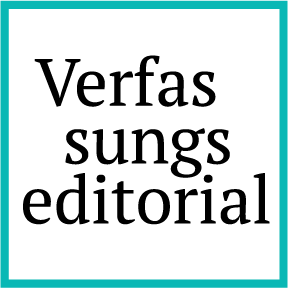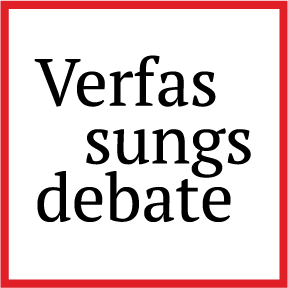A “One-Way Ratchet”?
Tariffs, the Major Questions Doctrine, and the Growth of Presidential Power
On Wednesday, November 5, 2025, the U.S. Supreme Court heard one of the most anticipated oral arguments in recent times. In the consolidated case Learning Resources v. Trump and Trump v. V.O.S. Selections, Inc., the Court is examining the legality of President Trump’s use of emergency powers to impose sweeping tariffs. The case lies at the intersection of two powerful, and potentially conflicting, trends in the Court’s recent jurisprudence: on the one hand, efforts to constrain delegations of power to the executive; on the other, a recurring embrace of expansive presidential authority, particularly when asserted by Trump. Each possible path carries significant risks – not only for the Supreme Court, but for the broader balance of powers in the U.S. constitutional system.
The tariffs’ road to the U.S. Supreme Court
Soon after returning to the White House in January, President Trump began invoking the International Emergency Economic Powers Act of 1977 (IEEPA) to unilaterally impose tariffs. In February, he ordered duties on goods from Canada, Mexico, and China, which he justified as measures to combat the inflow of opioids. On “Liberation Day” in April, he dramatically expanded the tariffs to cover more than 100 countries, arguing they were needed to reduce trade deficits and rebuild U.S. manufacturing. By some estimates, IEEPA has now been used to subject nearly one-third of all U.S. imports to tariffs.
While previous presidents have relied on IEEPA to impose sanctions and embargoes, Trump is the first to use it for tariffs. Critics denounced the move as unlawful overreach, and lawsuits were quickly filed by affected businesses and several U.S. states. In May, the U.S. Court of International Trade ruled that Trump had exceeded his authority and vacated the “Liberation Day” tariffs. The Federal Circuit Court of Appeals affirmed the holding in August. In a parallel case, the District Court for the District of Columbia likewise concluded in May 2025 that the tariffs were unlawful. However, the decisions were stayed to allow the administration time to appeal. The Supreme Court decided to hear the cases in September, consolidated them, and placed them on an expedited schedule.
Now it is up to the Supreme Court to decide whether IEEPA authorizes President Trump’s tariffs and, if so, whether this delegation of power is constitutional.
A question of statutory interpretation
At first glance, the case might appear to turn on a relatively straightforward issue of statutory interpretation. IEEPA authorizes the President, upon declaring a national emergency, “by means of instructions, licenses, or otherwise” to
“investigate, block during the pendency of an investigation, regulate, direct and compel, nullify, void, prevent or prohibit, any acquisition, holding, withholding, use, transfer, withdrawal, transportation, importation or exportation of, or dealing in, or exercising any right, power, or privilege with respect to, or transactions involving, any property in which any foreign country or a national thereof has any interest by any person, or with respect to any property, subject to the jurisdiction of the United States”.
Breaking down this complex provision presents the Supreme Court with a narrowly framed interpretive question: Does the authority to “regulate” the “importation” include the power to impose tariffs? Under the prevailing textualist approach, the analysis would focus on the plain meaning of the statutory text, asking how an ordinary reader would understand “regulate”. Does that term encompass “regulate by imposing tariffs”? On its face, the answer could go either way.
Yet, in this case, there is reason to think that ordinary principles of interpretation may prove inadequate. In recent years, the Supreme Court has developed a special interpretive principle that departs from ordinary standards: the major questions doctrine. If applied here, it would weigh heavily against the President’s claim to sweeping tariff authority under IEEPA.
The major questions doctrine
Although its roots reach further back, the major questions doctrine has taken its current form only recently. The Supreme Court formally announced the doctrine in West Virginia v. Environmental Protection Agency (2022), where it assessed the Environmental Protection Agency’s (EPA) authority to regulate greenhouse gas emissions under the Clean Air Act. The EPA’s Clean Power Plan required power plants to shift electricity production to lower-emission sources. In a 6-3 decision authored by Chief Justice John Roberts, the Court’s “conservative” majority held that the statute did not grant the EPA authority to adopt such a transformative regulatory scheme, with the “liberal” justices dissenting.
Rather than applying ordinary principles of statutory interpretation, the Supreme Court developed a new framework. It declared that there are “extraordinary cases” in which the “history and the breadth” of the asserted authority, and its “economic and political significance”, provide a “reason to hesitate before concluding that Congress meant to confer such authority”. In these major questions cases, agencies must point to “clear congressional authorization” for the powers they claim. A merely plausible textual basis will not suffice.
From a German or Austrian perspective, a doctrine holding that agencies may make major policy decisions only when the legislature has expressly and specifically authorized them to do so may sound unremarkable: Both systems require that statutes substantively predetermine executive rulemaking with sufficient specificity, reserving “essential” decisions for the legislature itself. In the U.S. context, however, the implications are revolutionary. Broad, open-ended delegations have long been a defining feature of American administrative law. The major questions doctrine abruptly undermines that foundation, and the consequences were quick to follow. In rapid succession, the Supreme Court invoked the concept to invalidate several high-profile measures of the Biden Administration, including a COVID-19 vaccine mandate for large employers and the Secretary of Education’s broad student loan forgiveness program.
Viewed through this lens, the tariffs case presents a formidable challenge for President Trump. The question is no longer whether “regulate” the “importation” could plausibly include the power to impose tariffs, but whether IEEPA provides the clear congressional authorization that the major questions doctrine demands. That is a high bar – one which IEEPA likely does not meet. The statute contains no reference to “tariffs”, “duties”, “imposts”, or “customs”, nor does it mention any authority to levy “taxes”. Consequently, the lower courts applying the doctrine concluded that IEEPA does not authorize Trump’s tariffs and declared them unlawful.
The Supreme Court could avoid this result by declining to apply the major questions doctrine altogether. But that seems hard to justify. The tariffs, claimed to generate revenue in the trillions of dollars over the coming years, plainly involve matters of vast “economic and political significance”. The sums far surpass the $ 500 billion at issue in President Biden’s student loan case, which the Court described as “staggering by any measure”.
One possible option to avoid the major questions test would be to carve out a foreign-policy exception, since the doctrine has not yet been applied in that realm (remarkably, Justice Brett Kavanaugh emphasized this point in a recent concurrence). Even so, this argument faces significant obstacles. While tariffs relate to international trade, they are ultimately domestic in effect as a tax on American importers and consumers. Several justices underscored this point during oral argument, among them – crucially – Chief Justice Roberts. Given that the Constitution explicitly assigns the “Power to lay and collect Taxes, Duties, Imposts and Excises” to Congress, it seems especially tenuous to place the power to impose tariffs within a realm of executive authority that does not require clear congressional authorization. After all, “taxation without representation is tyranny” famously served as a rallying cry of the American Revolution.
Thus, while not impossible, escaping the gravitational pull of the major questions doctrine seems difficult. However, this trajectory collides with another central trend in the Court’s jurisprudence: its deference to expansive presidential power.
The rise and rise of presidential power
So far, the Supreme Court has been largely receptive to President Trump’s sweeping claims of authority. With a compliant Republican-controlled Congress, the task of checking executive overreach has largely fallen to the judiciary. Many lower courts – including judges appointed by presidents of both parties – have attempted to do so, repeatedly holding that the administration’s actions exceeded statutory or constitutional limits.
The Supreme Court, however, has frequently overturned lower courts and sided with the administration, particularly through decisions issued on its so-called “shadow docket”, which comprises emergency rulings handed down without full briefing or oral argument but capable of having wide-ranging effects. In a series of such orders, the Court has permitted the President to implement far-reaching measures: slashing federal agencies’ staff (thereby, for example, gutting the Department of Education), removing the heads of independent agencies such as the Federal Trade Commission, and freezing congressional appropriations. Measure by measure, decision by decision, power traditionally reserved for Congress shifts steadily to the executive branch.
The Supreme Court’s “liberal” justices have consistently objected to this practice. “Our emergency docket should never be used, as it has been this year, to permit what our own precedent bars”, Justice Elena Kagan wrote, adding:
“Still more, it should not be used […] to transfer government authority from Congress to the President, and thus to reshape the Nation’s separation of powers.”
In the same vein, Justice Sonia Sotomayor criticized a recent decision as “indefensible”, as
“[i]t hands the Executive the power to repeal statutes by firing all those necessary to carry them out. The majority is either willfully blind to the implications of its ruling or naive, but either way the threat to our Constitution’s separation of powers is grave.”
While the motivations behind the individual decisions may vary, the overall pattern is unmistakable: a gradual judicial accommodation of the ongoing aggrandizement of presidential power, likely with lasting institutional consequences.
Between a rock and a hard place?
The tariffs case marks the first time in President Trump’s second term that the Supreme Court will assess the legality of a major policy initiative of the administration on its regular merits docket. The Court now stands at a crossroads. One path follows the major questions doctrine, striking down the tariffs for lack of clear congressional authorization. The other follows the approach the Court has recently often taken on its “shadow docket”, allowing the continued expansion of presidential power. Each way carries profound risks.
Invalidating the tariffs would strike at the heart of President Trump’s agenda and could trigger a direct confrontation between the executive and the judiciary. The President has repeatedly underscored the political stakes of the case, warning that an adverse decision would bring “ruinous” consequences. On the eve of oral argument, he declared the tariffs case “literally, LIFE OR DEATH for our Country”, asserting that without a victory, the U.S. would be “virtually defenseless against other Countries who have, for years, taken advantage of us”. This apocalyptic framing – echoed in the administration’s briefs – seemed calculated to remind the justices of the fierce reaction they might face if they rule against the President. The administration’s prior conduct gives weight to these warning signs. It has already shown a willingness to defy lower-court orders, and Vice President J.D. Vance – long before assuming office – had openly urged Trump to disregard the Supreme Court if it stood in the way of his plans to radically restructure the federal bureaucracy. Earlier this year, Vance reiterated that “judges aren’t allowed to control the executive’s legitimate power”, while Trump himself declared in an ominous social-media post: “He who saves his Country does not violate any Law”. Striking down the tariffs could therefore provoke the very constitutional crisis that many have feared and the administration appears to be preparing for.
The alternative path, however, carries its own set of risks. Upholding the tariffs could further erode public trust in the Supreme Court. Approval of the Court is near a historic low, and many Americans view the Justices as “politicians in robes”. If the Court declines to apply the major questions doctrine to Trump’s tariffs after wielding it repeatedly as a “powerful weapon” to strike down the Biden Administration’s regulatory initiatives, it risks fueling the charge of partisanship that has dogged the doctrine since its inception. Conversely, using it here could help rehabilitate perceptions of judicial neutrality by demonstrating that the doctrine does in fact constrain executive excesses, regardless of ideological alignment.
However, the consequences of upholding the tariffs would extend far beyond the standing of the Supreme Court. During oral argument, Justice Neil Gorsuch – one of Trump’s own appointees and a potential pivotal vote – expressed concern about the long-term institutional implications of validating the tariffs under IEEPA. He noted that while, in theory, Congress could amend the statute to curb presidential authority, that safeguard is illusory in practice. Any legislative effort to limit presidential power would face a presidential veto, and overriding it would require two-thirds majorities in both chambers, which seems nearly impossible in the current era of polarization. “Congress, as a practical matter, can’t get this power back once it’s handed over to the president”, Gorsuch observed, describing the dynamic as “a one-way ratchet toward the gradual but continual accretion of power in the executive branch and away from the people’s elected representatives”.
The implications of that warning reach well beyond tariffs. The case confronts the Supreme Court with a defining question: How will it respond to an accelerating concentration of power in the presidency at a time when Congress appears increasingly incapable of functioning as an effective counterweight? The Court’s response will shape not only its own legacy, but the future of the American constitutional order. Perhaps the Supreme Court will find guidance in a passage of Justice Robert Jackson’s famous concurrence in Youngstown Sheet & Tube Co. v. Sawyer (1952) – where the Court struck down President Truman’s use of emergency powers to seize steel mills during the Korean War – which Neal Katyal, representing the private litigants in oral argument, recalled in his closing remarks:
“With all its defects, delays and inconveniences, men have discovered no technique for long preserving free government except that the Executive be under the law, and that the law be made by parliamentary deliberations. Such institutions may be destined to pass away. But it is the duty of the Court to be last, not first, to give them up.”



